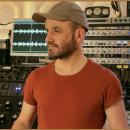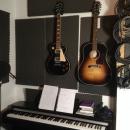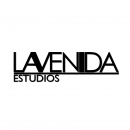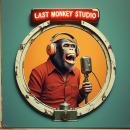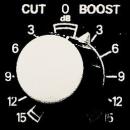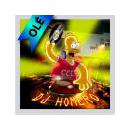Después del análisis de los datos de distorsión armónica que ponderaste como no fuera de lo común; pero buenos y de rango dinámico sí fuera de los común, resulta muy extraño que una empresa como Solid State Logic saque un producto para pro y semi pro con esos resultados tan ruidoso.
¿No puede haberse estropeado algo de la circuitería o alimentación periférica a los convertidores?.
Es imposible que S.O.S. escribiera:
MX Configuration
The rear panels of both versions of the MX look the same, offering three female 25-pin D-subs, a twin SC 50/125u fibre-optic MADI port (65/125u-compatible), a pair of word clock BNCs (in and out), and a USB B-socket that is used for firmware upgrades. The D-subs are wired to the Tascam eight-channel balanced audio convention (10kΩ input and 100Ω output impedances), with two handling 16 channels of audio in one direction and the third four channels in the opposite. A dual DIP switch is used to assign the interface to the required block of 16 MADI channels, and mains power is connected via an IEC inlet (auto-sensing 100-240V AC).
The front panel is not much more complicated than the rear, and the styling is very smart and elegant. A circular rocker switch powers the unit on-off, while four push-buttons configure the unit, with the status indicated on a display panel above. The first button toggles through the MADI channel count and frame modes (assuming the interface is acting as system master), offering 56 or 64 channel frames at single or dual sample rates. At the time of writing, the display can indicate quad-rate modes but this option is not supported in the current version (v1.0). However, it should be available as a downloadable update by the time you read this. The MX interfaces support the current standard 'high-speed' MADI format, for elevated sample rates, as well as the legacy S/MUX format. If all is well, the appropriate displays illuminate in green, but turn red if the received MADI stream does not match the current configuration.
Moving along, the second button toggles through the internal sample-rate options, with displays for 44.1 and 48kHz, plus x2 and x4 multipliers. Since the sample rate cannot be determined from a fixed data-rate MADI stream, the audio sample has to be set appropriately, whether the interface is master or slave. Again, the indicator illuminates in red if there is a configuration mismatch.
Holding both the MADI format and Sample Rate buttons simultaneously for a couple of seconds engages a diagnostic mode in which the channel format and sample rate of the received MADI stream are displayed as flashing lights in the corresponding display sections.
Next up are the clock-source options, comprising internal, word clock or MADI stream, with red indication for clock incompatibilities. The word clock input accepts TTL-compatible clock signals between 3V and 5V, but the output generates a 3.3V signal, which may not be recognised by some legacy equipment.
The final button sets the analogue headroom, to determine the analogue audio level corresponding to 0dBFS on the MADI stream. The two standard modes are +18dBu (EBU) and +24dBu (SMPTE), but holding the button depressed for a couple of seconds makes additional options available so that the level can be set in 1dB increments anywhere between +14 and +24dBu, using the four output channel indicators to reflect the selected level during configuration.
The right-hand side of the display section is taken up with numbered indicators that serve as basic audio level meters. These are presented as one block of four and another of 16, representing the inputs and outputs according to the model. If the corresponding audio-channel signal level lies below -75dBFS, the indicator is unlit, turning green for signals between -75 and -3dBFS. Above this level, the indicator turns amber, and then red for the last 0.5dBFS, flashing with prolonged overloads.
In Use
The Alpha-Link MX is a very straightforward interface to configure and use. It just gets on quietly with providing the relevant input and outputs with high-quality conversion. To start with, I hooked up a pair of MX units back-to-back to provide an analogue-MADI-analogue signal path, and connected an Audio Precision test-set to run it through its engineering paces.
The round-trip analogue-analogue latency is 1.95ms at a 44.1kHz sample rate, falling to 0.9ms at 96kHz — the bulk of the delay coming from the delta-sigma converters themselves, of course. I measured the -3dB low-frequency limit at 6Hz, with a smooth roll-off below that. The upper limit is determined by the sample rate and the converter's filter design, of course. In this case, it was clear that the Alpha-Link MX uses standard 'half-band' converter chips, since the filter attenuation was barely 6dB at half the sample rate. Although this is completely at odds with Mr Nyquist's well-known requirements, it's actually a very common converter implementation, which maximises audio bandwidth and minimises in-band phase shifts, but at the potential expense of audible aliasing artifacts if there is a lot of high-energy, high-frequency content — such as might be found if you were close-miking brass or string instruments, or those nasty metal plates that drummers like to bash regularly! In such situations, switching to a double sample rate may sound better, as it extends the audio bandwidth in the digital domain, leaving room for the inherent microphone HF roll-off to take care of excessive high-end energy in a natural way.
Measuring the crosstalk provided varying results, depending on which analogue channels were tested, but it was always better than 109dB at 10kHz, which is impressive. The signal-to-noise ratio of the complete analogue-MADI-analogue signal path relative to a +24dBu input signal was 112dB A-weighted (109dB flat), and that corresponds to 92dB SNR relative to a +4dBu reference level. That matches the typical performance of most high-end analogue consoles and outboard equipment. The AES17 standard dynamic-range test result through the A-D and D-A converters back-to-back was 108.5dB (rising to 112dB if I adopted Focusrite's preference for A-weighting), which equates nicely with the signal-to-noise ratio measurements.
A dynamic range of 108.5dB indicates a converter 'resolution' of just 18 bits, which might seem a tad disappointing — but, while the best AES17 figure I've measured to date (the Lynx Hilo), was 116dB (19.3 bits), most 'high-end' converters achieve similar results. As if to confirm the quality of these converters, I measured a total harmonic distortion (THD) figure (ref. +24dBu) of just 0.003 percent, and at a reference level of +4dBu this fell to 0.0007 percent, which is highly commendable.
In critical listening tests, the Alpha-Link MX converters are as close to a piece of straight wire as you can reasonably expect. There's no discernible sonic character, the audio throughput is completely transparent, and the noise floor is extremely low and completely benign. Examination of an FFT plot of the noise floor revealed a probable mains-related harmonic component around 250Hz, and a couple of sample-rate related 'idle tones', but these were all comfortably below -115dBu and of no practical concern at all. I compared the Alpha-Link's performance directly against my reference two-channel Benchmark and Crookwood converters and found very little to choose between them, which says a lot when you consider the relative costs per channel!
Verdict
SSL's Alpha-Link MX converters are well-conceived and highly practical interfaces that will meet many user's needs far better than the standard MADI interfaces, both in terms of channel count and cost, while allowing easy future expansion, should the need arise. The technical and sonic performance is very good, configuring a system is simple, and the cost is very attractive. It seems that the project-studio market has finally recognised the merits of MADI interfacing, and SSL are offering a cost-effective way in! .
pros
Ability to choose the I/O balance to suit application.
Very good technical and sonic performance.
Easy configuration.
Algo no me está cuadrando.
Responder
Citar

